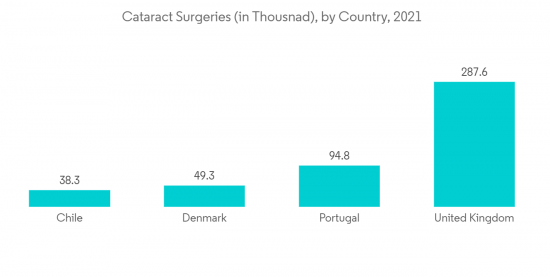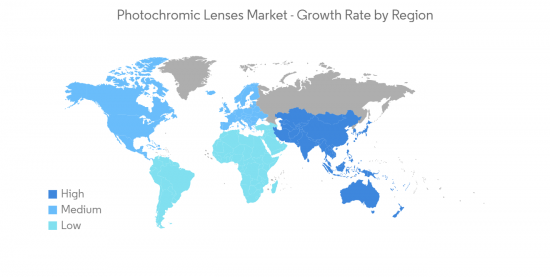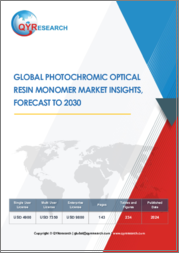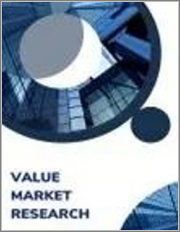
|
시장보고서
상품코드
1333721
세계의 포토크로믹 렌즈 시장 규모, 점유율 분석 : 성장 동향 및 예측(2023-2028년)Photochromic Lenses Market Size & Share Analysis - Growth Trends & Forecasts (2023 - 2028) |
||||||
포토크로믹 렌즈(Photochromic Lenses) 시장 규모는 2023년 68억 8,000만 달러에서 2028년 91억 3,000만 달러로 성장할 것으로 예상되며, 예측 기간(2023-2028년)의 CAGR은 5.81%가 될 것으로 예측되고 있습니다.
팬데믹 기간 중에 세계 각국은 COVID-19의 상당한 위협에 직면 해 왔습니다. 여러 국가가 다른 국가와의 무역을 중단하고 여행 제한 등을 시행하면서 전 세계 주요 기업의 시가총액이 감소하고 산업 생산 및 기타 비즈니스 활동이 위축되었습니다. 그러나 봉쇄로 인해 디지털 학습과 업무가 증가하면서 근시와 같은 시력 관련 문제가 발생했다는 증거가 증가하고 있습니다. 또한 팬데믹 이후 대부분의 국가가 여행 제한 조치를 해제하고 수요와 공급 측면이 정상 궤도에 오르는 것도 향후 시장 성장의 요인 중 일부입니다.
시장 성장의 중요한 요인은 포토크로믹 렌즈의 채택이 확대되고 있는 것이며, 노인층에서 포토크로믹 렌즈의 수요 증가가 포토크로믹 렌즈 시장을 촉진할 것으로 예상됩니다. 예를 들어 일본은 세계에서 가장 빠르게 고령화가 진행되고 있는 국가입니다. World Ageing 2019' 보고서에 따르면 2019년 일본의 65세 이상 인구는 3,552만 4,000명(28%)으로, 2030년에는 3,727만 8,000명(30.9%)에 달할 것으로 예측되고 있습니다. 앞으로는 눈과 관련된 장애를 일으키기 쉬운 노년 인구가 증가할 것으로 예상되며, 궁극적으로 시장 성장을 촉진할 것으로 기대됩니다.
전 세계의 눈 건강을 개선하기 위한 정부와 민간 단체의 구상은 앞으로 수년간 포토크로믹 렌즈 시장을 가속화할 것으로 예측됩니다. 2021년 5월 세계보건기구(WHO)가 발표한 데이터에 따르면 전 세계 8억명 이상의 사람들이 원시나 근시 등 원시시력장애를 안고 있으며, 적절한 안경을 사용하여 치료 가능합니다. 그러므로 여러 조직과 시장 관계자의 인지도 향상으로 치료에 대한 접근성이 향상되면 시장 성장이 촉진될 수 있습니다.
기술 진보, 소매점 증가, 편안함 및 스타일 향상과 같은 추가 요인이 예측 기간 중 광변색 렌즈 시장을 촉진할 것으로 보입니다. 안병 환자 증가, 안과 진단 절차 증가, 개인의 의식 향상이 포토크로믹 렌즈 시장 성장에 긍정적인 영향을 미칠 것으로 보입니다.
포토크로믹 렌즈 시장 동향
예측 기간 중 교정용 렌즈가 큰 시장 점유율을 차지할 전망
교정 포토크로믹 렌즈는 처방 포토크로믹 렌즈로도 알려져 있으며, 처방 안경의 장점과 포토크로믹 렌즈의 광 적응 특성을 결합한 것입니다. 이러한 렌즈는 근시, 원시, 난시, 노안과 같은 굴절 이상을 교정하도록 설계되었으며 자외선에 반응하여 자동으로 색조를 조정하는 장점도 있습니다. 눈과 관련된 질병 증가와 주요 시장 진입 기업의 노력 등 요인은 예측 기간 중 조사된 시장 성장을 증가시킬 것으로 예상됩니다.
조사한 시장 성장에 기여하는 주요 요인은 눈 관련 장애의 발생률과 유병률 증가를 포함합니다. 예를 들어 세계보건기구(WHO)의 2021년 10월 보고서에 따르면 전 세계 약 22억명이 근견 또는 원견 시력장애를 안고 있으며, 그 중 약 10억건의 시력장애는 예방할 수 있습니다. 또는 예방할 수 있었을 수 있습니다. 전 세계 시력 장애 환자의 부담의 크기와 치료 가능성은 렌즈 수요의 높이를 나타내며 예측 기간 중 조사된 시장 성장에 긍정적인 영향을 미칠 것으로 예상됩니다. 마찬가지로 시력손실전문가그룹(VEEG)은 2021년 전 세계 11억 명이 시력 손실을 갖고 생활하고 있으며, 그 90%가 중저소득국(LMICs)에 살고 있다고 보고했습니다.
기업의 협정과 같은 노력은 시장에 새롭고 혁신적인 제품을 추가할 수 있으므로 성장을 돕는 중요한 요소 중 하나입니다. 예를 들어 2022년 3월 EssilorLuxottica는 CooperCompanies와 SightGlass Vision의 합작 계약을 체결했습니다. SightGlass Vision의 확산 광학 기술은 수천 개의 마이크로 도트를 렌즈에 통합하여 빛을 부드럽게 산란시켜 어린이의 근시 성장을 최소화합니다. 이것은 근시 관리 카테고리를 확장하는 새로운 안경 렌즈 기술의 상용화를 가속화합니다.
제품 출시는 조사한 시장 성장을 돕는 또 다른 요인입니다. 예를 들어 2023년 4월, HOYA Vision Care는 MiYOSMART Sun Series를 출시했습니다. 포토크로믹 안경 렌즈 'MiYOSMART Chameleon'과 편광 안경 렌즈 'MiYOSMART Sunbird'는 근시의 굴절 이상을 교정하고 근시의 진행을 늦추는 동시에 강한 햇빛으로부터 보호를 제공합니다.
이와 같이 광변색 렌즈의 장점을 강조하는 눈과 관련된 질병 증가와 시장 관계자의 노력이 조사된 시장 성장을 증가시킬 것으로 예상됩니다.

예측기간 중 북미가 큰 시장 점유율을 차지할 전망
북미 지역은 높은 수준의 헬스케어 인프라와 광변색 렌즈의 수요 증가로 큰 시장 점유율을 차지할 것으로 예상됩니다.
당뇨병 망막증(DR)은 당뇨병 환자들 사이에서 우려되는 주요 원인 중 하나이며, 종종 눈의 흐림, 눈의 통증, 갑작스런 시력 저하를 유발합니다. 따라서 대부분의 사람들은 더 나은 시력을 얻기 위해 예방 교정용 광변색 렌즈를 사용합니다. 이 지역에서 DR에 대한 우려가 높아짐에 따라 포토크로믹 렌즈의 수요가 증가하고, 조사된 시장 성장을 촉진하고 있습니다. 예를 들어 Jobson Healthcare Information LLC가 2022년 6월에 발표한 데이터에 따르면 당뇨병은 현역 세대 성인에서 실명의 주요 원인 중 하나입니다. 미국 당뇨병 성인의 11.7% 가까이 실명을 포함한 시력 장애를 가지고 있으며, 당뇨병 환자의 약 절반이 2030년까지 DR을 발병할 것으로 예측되고 있습니다.
또한 2022년 8월 Eyenuk Inc.가 발표한 보도 자료에 따르면 DR은 당뇨병성 안 질환 중에서 가장 흔한 질환 중 하나입니다. 캐나다에서는 2021년 75만 명이 DR을 앓고 DR이 캐나다의 의료 시스템에 미치는 경제적 영향은 연간 12억 달러였습니다. 이 높은 당뇨병 유병률은 광변색 렌즈의 채택을 증가시키고 분석 기간 중 조사한 시장 성장을 촉진할 것으로 예상됩니다.
또한 이 지역의 주요 시장 진입 기업에 의한 제품 승인 및 발매 증가도 성장을 지원할 것으로 예상되는 요인 중 하나입니다. 예를 들어 2021년 2월, 미국과 캐나다에서 EssilorLuxottica에서 Ray-Ban Authentic 제품 라인을 출시했습니다. 이 제품 라인은 포토크로믹 렌즈와 블루 라이트 필터를 이용한 전환 기술을 특징으로 합니다.
그러므로 대상 인구의 다양한 안질환 유병률 상승과 기업 활동 등 요인으로 인해 포토크로믹 렌즈 시장은 이 지역에서 큰 성장을 이룰 것으로 예측되고 있습니다.

광변색 렌즈 산업 개요
포토크로믹 렌즈 시장은 지역 및 세계 수준에서 사업을 도입하는 소수 시장 기업의 존재로 인해 약간 통합된 특성을 가지고 있습니다. 일부 유력 기업은 시장 포지션을 강화하기 위해 타사와의 인수와 신제품 출시를 정력적으로 시행하고 있습니다. 주요 기업으로는 Corning Incorporated, EssilorLuxottica SA, Carl Zeiss AG, Hoya Corporation, Vision Dynamics LLC 등이 있습니다.
기타 혜택 :
- Excel 형식의 시장 추정(ME) 시트
- 3개월간의 애널리스트 서포트
목차
제1장 소개
- 조사의 전제 조건과 시장 정의
- 조사 범위
제2장 조사 방법
제3장 주요 요약
제4장 시장 역학
- 시장 개요
- 시장 촉진 요인
- 포토크로믹 렌즈의 채택 확대
- OTC 제품의 광범위한 가용성
- 시장 억제 요인
- 위조품의 존재
- Porter's Five Forces 분석
- 신규 참가업체의 위협
- 구매자·소비자의 협상력
- 공급기업의 협상력
- 대체품의 위협
- 경쟁 기업간 경쟁 관계의 강도
제5장 시장 세분화(금액 기준, 시장 규모-100만 달러)
- 소재별
- 유리
- 폴리카보네이트
- 플라스틱
- 기술별
- 자외선 및 가시광선
- 흡수 및 트랜스 본딩
- 질량
- 기타 기술
- 용도별
- 교정
- 예방
- 판매 채널별
- 전문 클리닉
- 온라인
- 기타 판매 채널
- 지역별
- 북미
- 미국
- 캐나다
- 멕시코
- 유럽
- 독일
- 영국
- 프랑스
- 이탈리아
- 스페인
- 기타 유럽
- 아시아 태평양
- 중국
- 일본
- 인도
- 호주
- 한국
- 기타 아시아 태평양
- 중동 및 아프리카
- GCC
- 남아프리카
- 기타 중동 및 아프리카
- 남미
- 브라질
- 아르헨티나
- 기타 남미
- 북미
제6장 경쟁 상황
- 기업 개요
- Corning Incorporated
- EssilorLuxottica SA
- Apax Fund(Rodenstock GmbH)
- Carl Zeiss AG
- Hoya Corporation
- Vision Dynamics LLC
- Tokai Optical Co. Ltd
- Sundex Optical Co. Ltd
- Jiangsu Aogang Optical Glasses Co. Ltd
- GKB Ophthalmic Limited
제7장 시장 기회 및 향후 동향
LYJ 23.09.04The Photochromic Lenses Market size is expected to grow from USD 6.88 billion in 2023 to USD 9.13 billion by 2028, at a CAGR of 5.81% during the forecast period (2023-2028).
During the pandemic, countries across the world have been facing a considerable threat of COVID-19 (coronavirus). Several companies had suspended trade with other countries, implemented travel restrictions, etc., thus, leading to a decline in market capitalizations of major companies across the world, along with a decline in industrial production and other business activities. However, there has been increasing evidence of the development of vision-related problems, such as myopia, due to the increased adoption of digital learning and work due to the lockdown. Also, the removal of travel restrictions by most countries after the pandemic and getting back on track from the supply and demand sides are some of the factors responsible for the growth of the market in the coming years.
The significant factors attributing to the market's growth are the growing adoption of the photochromic lens and the increasing demand for photochromic lenses among the elderly population is expected to drive the photochromic lens market. For instance, Japan has the world's fastest aging population. According to the World Ageing 2019 report, the population above 65 years of age in Japan was 35.524 million (28%) in 2019, which is projected to reach 37.278 million (30.9%) in 2030. The geriatric population is expected to increase in coming years who are more prone to eye-related disorders, which is expected to ultimately drive the growth of the market.
Initiatives by the govenrment and private oragnizations to improve eye health across the world is projected to accelrate the photochromic lenses market in coming years. According to the data published by the World Health Organization in May 2021, greater than 800 million people across the world have distance impairment such as hypermetropia and myopia or near vision impairment that can be treat with an suitable pair of spectacles. Hence, improving access to treatment by increasing awarness by several organizations and marke players may propel the market growth.
Additional factors such as the advancements in technology, growing retail outlets, and gains in comfort and style are likely to drive the market for photochromic lenses during the forecast period. The continued growth of the increased cases of eye disease, increasing ophthalmology diagnostic procedures, and growing awareness among individuals are likely to have a positive impact on the growth of the photochromic lens market.
Photochromic Lenses Market Trends
Corrective Lens Expected to Hold a Significant Market Share over the Forecast Period
Corrective photochromic lenses, also known as prescription photochromic lenses, combine the benefits of prescription eyeglasses with the light-adaptive properties of photochromic lenses. These lenses are designed to correct refractive errors such as nearsightedness (myopia), farsightedness (hyperopia), astigmatism, or presbyopia while providing the added benefit of automatic tint adjustment in response to UV light. Factors such as the increasing incidences of eye-related disorders and initiatives by key market players are expected to increase the growth of the market studied over the forecast period.
The major factors that contribute to the growth of the market studied include the increasing incidence and prevalence of eye-related disorders. For instance, according to the October 2021 report of the World Health Organization, about 2.2 billion people across the world have near or distant vision impairment, of which approximately 1 billion cases of vision impairment can be prevented or could have been prevented. The high burden of cases of vision impairment around the world and the possibility of treatment indicate a high demand for lenses, which is expected to have a positive impact on the growth of the market studied during the forecast period. Similarly, the Vision Loss Expert Group (VEEG), in 2021, reported that globally, 1.1 billion people live with vision loss, and 90% of such people live in low- and middle-income countries (LMICs).
Initiatives such as agreements by companies are one of the key factors that aid growth as it leads to the addition of new and innovative products in the market. For instance, in March 2022, EssilorLuxottica signed a joint venture agreement with CooperCompanies for SightGlass Vision. SightGlass Vision's Diffusion Optics Technology softly scatters light by incorporating thousands of micro-dots into the lens to minimize the growth of myopia in children. This accelerates the commercialization of novel spectacle lens technologies to expand the myopia management category.
Product launches are another factor that aid in the growth of the market studied. For instance, in April 2023, HOYA Vision Care launched the MiYOSMART sun range. The photochromic spectacle lenses, MiYOSMART Chameleon, and polarised spectacle lenses, MiYOSMART Sunbird, provide protection from intense sunlight while correcting the myopic refractive error and slowing myopia progression.
Thus, the increasing incidences of eye-related disorders that highlight the advantages of photochromic lenses and initiatives by market players are expected to increase the growth of the market studied.

North America is Expected to Hold a Significant Market Share Over the Forecast Period
The North American region is expected to hold a significant market share due to the high standards of healthcare infrastructure and the rising demand for photochromic lenses.
Diabetic Retinopathy (DR) is one of the major causes of concern among people with diabetes, which most often causes blurred vision, eye pain, and sudden vision loss. Hence, most people use preventive and corrective photochromic lenses for better vision. With rising concerns about DR in the region, the demand for photochromic lenses is increasing and driving the growth of the market studied. For instance, according to data released by Jobson Healthcare Information LLC in June 2022, diabetes is one of the major causes of blindness in working-age adults. Nearly 11.7% of adults in the United States with diabetes have a vision disability, including blindness, and approximately half of the patients with diabetes are predicted to develop DR by 2030.
In addition, according to a press release published by Eyenuk Inc. in August 2022, DR is one of the most common forms of diabetic eye disease. In Canada, 750,000 people had DR in 2021, and the economic impact of DR on the Canadian healthcare system was USD 1.2 billion annually. This high prevalence of DR is expected to increase the adoption of photochromic lenses and fuel the growth of the market studied over the analysis period.
Furthermore, the increasing number of product approvals, as well as launches by the key market players in the region, is another factor that is predicted to boost growth. For instance, in February 2021, the Ray-Ban Authentic product line was launched by EssilorLuxottica in the United States and Canada. The product line features transition technology with photochromic lenses and blue light filtering.
Therefore, owing to the factors such as the rising prevalence of various eye disorders among the target population and company activities, the photochromic lenses market is anticipated to witness significant growth in the region.

Photochromic Lenses Industry Overview
The photochromic lens market is slightly consolidated in nature due to the presence of a few market players operating regionally and at the global level. Some prominent players are vigorously making acquisitions and releasing new products with other companies to consolidate their market positions globally. Some key players are Corning Incorporated, EssilorLuxottica SA, Carl Zeiss AG, Hoya Corporation, and Vision Dynamics LLC.
Additional Benefits:
- The market estimate (ME) sheet in Excel format
- 3 months of analyst support
TABLE OF CONTENTS
1 INTRODUCTION
- 1.1 Study Assumptions and Market Definition
- 1.2 Scope of the Study
2 RESEARCH METHODOLOGY
3 EXECUTIVE SUMMARY
4 MARKET DYNAMICS
- 4.1 Market Overview
- 4.2 Market Drivers
- 4.2.1 Growing Adoption of Photochromic Lens
- 4.2.2 Wide Range Availability of OTC Products
- 4.3 Market Restraints
- 4.3.1 Presence of Counterfeit Products
- 4.4 Porter's Five Forces Analysis
- 4.4.1 Threat of New Entrants
- 4.4.2 Bargaining Power of Buyers/Consumers
- 4.4.3 Bargaining Power of Suppliers
- 4.4.4 Threat of Substitute Products
- 4.4.5 Intensity of Competitive Rivalry
5 MARKET SEGMENTATION (Market Size by Value - USD million)
- 5.1 By Material
- 5.1.1 Glass
- 5.1.2 Polycarbonate
- 5.1.3 Plastic
- 5.2 By Technology
- 5.2.1 UV and Visible Light
- 5.2.2 Imbibing and Trans-bonding
- 5.2.3 In Mass
- 5.2.4 Other Technologies
- 5.3 By Application
- 5.3.1 Corrective
- 5.3.2 Preventive
- 5.4 By Sales Channel
- 5.4.1 Specialty Clinics
- 5.4.2 Online
- 5.4.3 Other Sales Channel
- 5.5 By Geography
- 5.5.1 North America
- 5.5.1.1 United States
- 5.5.1.2 Canada
- 5.5.1.3 Mexico
- 5.5.2 Europe
- 5.5.2.1 Germany
- 5.5.2.2 United Kingdom
- 5.5.2.3 France
- 5.5.2.4 Italy
- 5.5.2.5 Spain
- 5.5.2.6 Rest of Europe
- 5.5.3 Asia-Pacific
- 5.5.3.1 China
- 5.5.3.2 Japan
- 5.5.3.3 India
- 5.5.3.4 Australia
- 5.5.3.5 South Korea
- 5.5.3.6 Rest of Asia-Pacific
- 5.5.4 Middle East and Africa
- 5.5.4.1 GCC
- 5.5.4.2 South Africa
- 5.5.4.3 Rest of Middle East and Africa
- 5.5.5 South America
- 5.5.5.1 Brazil
- 5.5.5.2 Argentina
- 5.5.5.3 Rest of South America
- 5.5.1 North America
6 COMPETITIVE LANDSCAPE
- 6.1 Company Profiles
- 6.1.1 Corning Incorporated
- 6.1.2 EssilorLuxottica SA
- 6.1.3 Apax Fund (Rodenstock GmbH)
- 6.1.4 Carl Zeiss AG
- 6.1.5 Hoya Corporation
- 6.1.6 Vision Dynamics LLC
- 6.1.7 Tokai Optical Co. Ltd
- 6.1.8 Sundex Optical Co. Ltd
- 6.1.9 Jiangsu Aogang Optical Glasses Co. Ltd
- 6.1.10 GKB Ophthalmic Limited















